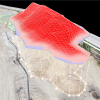- Joined
- Nov 30, 2019
- Messages
- 544
- Reaction score
- 290
- Age
- 51
- Location
- Leander, Texas
- Website
- www.admgeomatics.com
***Obviously this thread went its own way so feel free to comment on either topic, lol.
Been chatting in the Terrain Awareness thread which brought to mind another feature that is fairly recent that I am not sure how many people are using. Have you used the annotations feature on the 3D model? If so, what do you think? Do you have any issues? I usually digitize my areas in 2D with the Elevation layer on so that I can see well-defined breaklines and then go into 3D to make sure that I don't have any red/blue that is not needed for the situation. The 3D navigates nicely, but I do have some issue manipulating the 3D vertices as they seem hard to pick.

A tip is to change the Elevation slider to isolate the elevation range of the area you are in. This site has a pretty good elevation change so the colors are spread further and there isn't as much definition in each area.


With annotations... This is where the 3D is valuable as I need to eliminate the blue to get as close to true export as possible. Within time consumption reason...



Been chatting in the Terrain Awareness thread which brought to mind another feature that is fairly recent that I am not sure how many people are using. Have you used the annotations feature on the 3D model? If so, what do you think? Do you have any issues? I usually digitize my areas in 2D with the Elevation layer on so that I can see well-defined breaklines and then go into 3D to make sure that I don't have any red/blue that is not needed for the situation. The 3D navigates nicely, but I do have some issue manipulating the 3D vertices as they seem hard to pick.

A tip is to change the Elevation slider to isolate the elevation range of the area you are in. This site has a pretty good elevation change so the colors are spread further and there isn't as much definition in each area.


With annotations... This is where the 3D is valuable as I need to eliminate the blue to get as close to true export as possible. Within time consumption reason...



Last edited:












